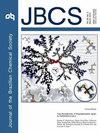丁香精油海藻酸钙微胶囊的杀幼虫活性研究
IF 1.3
4区 化学
Q3 CHEMISTRY, MULTIDISCIPLINARY
引用次数: 0
摘要
精油(EO)具有多种用途,如抗菌和抗真菌活性。然而,它们在空气、光和湿气的存在下容易氧化。此外,它们是热不稳定的。从这个意义上说,有必要开发延长EO寿命的技术。本研究从丁香中提取EO,并采用不同的工艺进行表征。主要化合物为丁香酚(83%)、丁香酚醋酸酯(9%)和β-石竹烯(8%)。采用微流控装置对EO进行挤压封装。以海藻酸钠为壁材,CaCl2溶液为交联剂。微胶囊尺寸为164.7±0.3µm,包封率为64±14%。用红外光谱和拉曼光谱观察了微胶囊中EO的功能特征基团。微胶囊使EO的热分解从162℃提高到230℃。进行了胶囊的释放动力学,平衡时间为72 h,释放了54%的EO。最后,将纯EO和包封EO微胶囊用于埃及伊蚊幼虫对照,结果表明,纯EO和包封EO微胶囊消除50% (LC50)所需的平均致死浓度分别为74.4和96.9µg mL-1,消除90% (LC90)所需的平均致死浓度分别为106.2和133.3µg mL-1。因此,该微胶囊在控制埃及伊蚊幼虫方面具有一定的应用潜力。本文章由计算机程序翻译,如有差异,请以英文原文为准。
Larvicidal Activity of Calcium Alginate Microcapsules Containing Clove Essential Oil Obtained by Microfluidics
Essential oils (EO) have diverse applications, such as antibacterial and antifungal activity. However, they are susceptible to oxidation in the presence of air, light, and moisture. In addition, they are thermally unstable. In this sense, it is necessary to develop techniques to increase the lifespan of EO. In this work, EO was obtained from cloves and characterized by different techniques. The major compounds found were eugenol (83%), eugenol acetate (9%), and β-caryophyllene (8%). The EO was encapsulated by extrusion using a microfluidic device. The sodium alginate was used as wall material, and the CaCl2 solution was used as a crosslinking agent. The microcapsule presented sizes of 164.7 ± 0.3 µm, with an encapsulation yield of 64 ± 14%. Functional characteristic groups of EO were observed in the microcapsule by infrared and Raman spectroscopies. The microcapsule increased the thermal decomposition of the EO from 162 to 230 °C. Release kinetics of the capsule was performed, with an equilibrium time of 72 h and release of 54% of the EO. Finally, the pure EO and encapsulated EO-microcapsules were applied in the Aedes aegypti larvae control, showing mean lethal concentration necessary to eliminate 50% (LC50) values of 74.4 and 96.9 µg mL-1 and lethal concentration necessary to eliminate 90% (LC90) of 106.2 and 133.3 µg mL-1 for pure EO and encapsulated EO, respectively. Therefore, it was concluded that these microcapsules have the potential for application in the Aedes aegypti larvae control.
求助全文
通过发布文献求助,成功后即可免费获取论文全文。
去求助
来源期刊
CiteScore
2.90
自引率
7.10%
发文量
99
审稿时长
3.4 months
期刊介绍:
The Journal of the Brazilian Chemical Society embraces all aspects of chemistry except education, philosophy and history of chemistry. It is a medium for reporting selected original and significant contributions to new chemical knowledge.

 求助内容:
求助内容: 应助结果提醒方式:
应助结果提醒方式:


